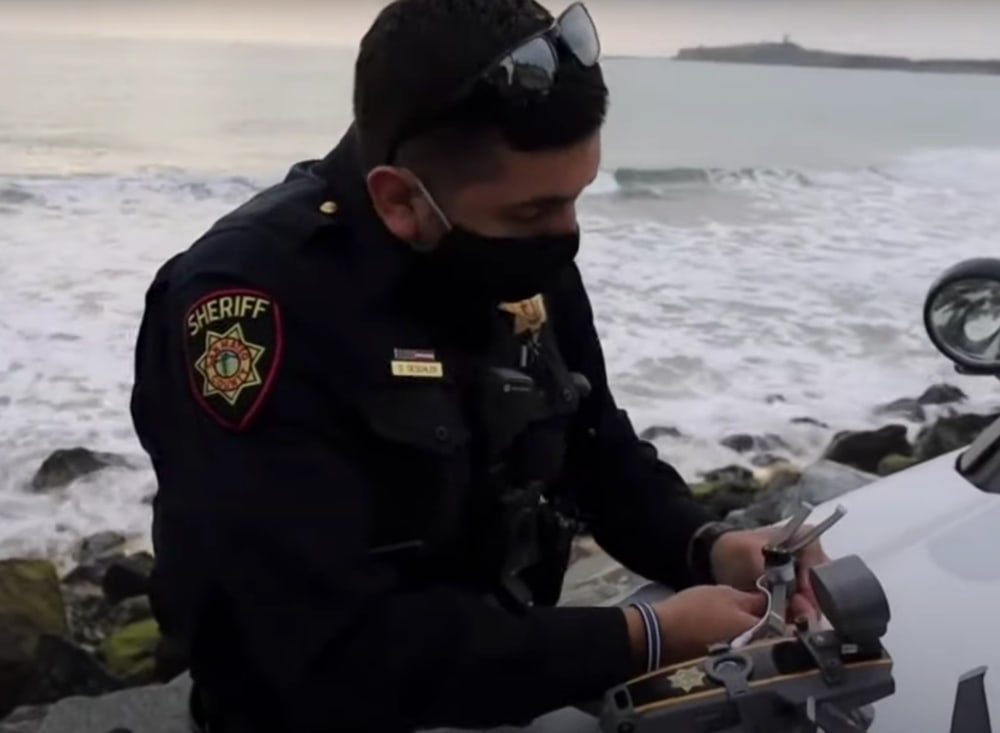Drones as Lifeguards—Police in San Mateo, CA Test the Use of Drones to Save People from Drowning
BY Zacc Dukowitz
15 April 2021The San Mateo Sheriff’s Office is testing the use of drones as lifeguards.
Rather than diving into the water to rescue people in distress, the drones will be used to carry and drop life jackets into the water.
In 2019 and 2020 the San Mateo sheriff’s office responded to double the amount of water rescues than it had in past years. And in the first month of 2021, two people drowned.
At the beginning of the year when we had two of those fatal drownings, we really kind of stepped up our efforts as far as research and getting those tools in place sooner than later.
– Rosemerry Blankswade, Spokesperson for the San Mateo Sheriff’s Office
Apparently the sheriff’s office has seen an uptick in beach visits during quarantine, which has led to a corresponding uptick in drownings and the need for rescues at sea. Clearly, the need was already there based on data from the past two years, but COVID-19 has only made the situation more dire.
The sheriff’s office launched its drone program about a year ago, but didn’t get the idea to use drones for water rescues until recently, when someone in the department learned of a volunteer firefighter who had been exploring the idea.
How Does It Work?
The idea behind the “drone as lifeguard” is straightforward: you fly a life jacket to a person struggling in the water, and drop it down to them.
The key ingredient in making this work is the payload.
To carry and drop life jackets, the sheriff’s office uses a unique payload that holds the life jacket in place. Once the pilot wants to drop the life jacket, they can do so by pressing a button on the remote control.


An officer explains how the payload works (shown at 00:13 in the video above)
Using a drone to get a life jacket to a distressed person in the water is generally faster than swimming out to rescue them. According to the sheriff’s office, once officers arrive on the scene they can get a drone with the special life jacket payload in the air in just a few minutes.
The drone isn’t necessarily the only tool to help a drowning person. In-person help may also be needed.
But the drone can act as a first responder, getting a distressed swimmer the help they need right away so they can stay afloat until someone gets there to provide further assistance.
[Related read: 6 Ways Police Departments Use Drones in Their Work]
One complicating factor with this approach is getting the drop just right.
In general, officers are dropping the life jackets from 15 to 25 feet in the air, which can make it hard to place them right where they need to go in the water. Strong winds, limited visibility, and the challenges of depth perception all make hitting a target in the water difficult.
Depth perception is really hard. I think they just err on the side of caution and stay a little bit higher. But, ideally, we would like to get a lot more practice in trying to kind of get the life jacket directly to the person.
– Rosemerry Blankswade, Spokesperson for the San Mateo Sheriff’s Office
Since adopting the drone lifeguard initiative a few months back, the sheriff’s office has been focused on intensively training its pilots for water rescues. The goal is to get them up to speed for the warmer months ahead, when there will be more people at the beaches and in the water.
Drone pilots in the San Mateo Sheriff’s Office are strategically placed in every bureau it serves, so a pilot can be called to help assist in a rescue as quickly as possible. The department currently has eight drone pilots, and is hoping to add more drones and drone pilots in the near future.
Drones and Sharks
Another way drones have been helping keep the oceans safe for people is by spotting sharks from the sky.
A project called SharkEye based at U.C. Santa Barbara has been using drones to monitor the ocean for great whites. The approach is currently manual, with pilots manually flying drones and looking for sharks in the water, then reporting the day’s findings through radio broadcasts.
But researchers are working on a system that will combine AI and drone technology to automate the entire process, from the drone flights through to the analysis of the visual data, so that reports can be automatically created that will identify the presence of sharks in the ocean.
The AI system is currently being trained to take raw drone footage of the ocean and, through machine learning, recognize the presence of great white sharks.
![]()
![]()
Image credit: SharkEye
Although the SharkEye program is still a ways from going live—at least in its fully automated form—researchers in Australia have already completed a trial of AI software that also uses machine learning to identify and track sharks with visual data collected by drones.
![]()
![]()
Photo credit: Surf Life Saving NSW
The software was tested in June of 2020 at five different beaches, and the results were promising. It was able to successfully identify and track the presence of several species of sharks using a “machine learning algorithm that runs on mobile devices” according to Dr. Cormac Purcell, the Project Lead for the effort.
According to the researchers leading the project, it was the first independent, scientific trial of an AI algorithm for detecting shark species by drone.
Know of other ways drones are being used for good? Share what you know in this thread on the UAV Coach community forum.


